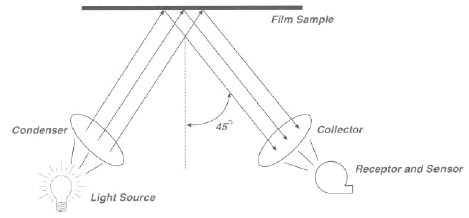Gloss
Definition
Relevance to performance
What affects film gloss
Test principles
Definition
Gloss is a measurement of the relative luster or shininess of a film surface. ExxonMobil uses 45-degree gloss, where the incident light beam strikes the film surface at a 45 degree angle from the perpendicular. A sensor measures the amount of light reflected by the film at a mirror image angle. The gloss value is the ratio of this reflected light to incident light and is reported in gloss units. Theoretically, the range of the gloss scale is 0 to 100.
Relevance to application performance
Shininess, brilliance, and sparkle are properties related to a film's gloss value. They can be valuable appearance attributes for packages, labels, or graphic arts items.
Precise comparisons of gloss values can only be made when the measurements are performed on samples of the same general type of material, using the same procedure and test angle. In particular, it is not valid to compare the gloss values of transparent films and opaque films.
What affects film gloss
Gloss is primarily determined by material selection and surface smoothness, which are defined during product and process development. Day-to-day process variations will have an insignificant effect on gloss. Transparent films have two reflecting surfaces. Although rare, this can lead to gloss values that exceed 100.
Test principles
ExxonMobil uses commercially available glossmeters to measure 45-deg gloss consistent with ASTM procedure D 2457. The simplified diagram in Figure 2 graphically summarizes the test.
 |
| Figure 2: Gloss measurement |

